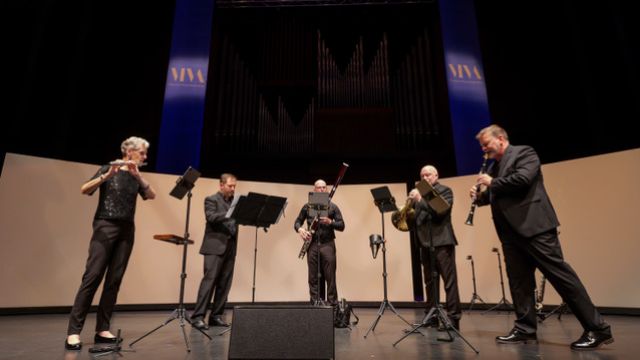Ensemble Q and William Barton
Ensemble Q and William Barton, featuring some of Australia’s finest musicians have crafted a smorgasbord of music including works by William Barton and Paul Dean alongside hand-picked masterpieces by Brahms and Ligeti, which promise to wrap audiences in a multi-layered experience of sound. It is the perfect fusion of western and first nation musical legacies with a World Premiere included and who doesn’t love a World Premiere?
Add to this clever selection of musical pieces the best welcome to country I have ever heard, moving, heartfelt and totally inclusive, and you have an exciting night of musical excellence thanks to Alison Mitchell (flute), Huw Jones (oboe), Paul Dean (co-artistic director and clarinet), David Mitchell (bassoon), Peter Luff (horn), Trish Dean (co-artistic director and cello), Phoebe Rusell (double bass) and William Barton (didgeridoo/composer).
The all too brief Six Bagatelles for Wind Quintet by György Ligeti opens the programme. Between 1951 and 1953, the Hungarian-Austrian composer, Ligeti, composed a set of 11 bagatelles for piano, titled Musica Ricercata. The composer explained, “I began to experiment with amazingly simple structures of rhythms and sonorities - as if to build up a ‘new music’ from nothing.”
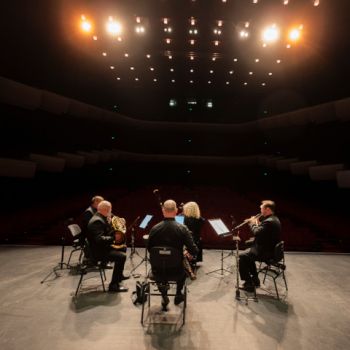
Ligeti transcribed excerpts from the collection to create the wonderfully whimsical Six Bagatelles for Wind Quintet. Each of the movements evokes a distinct atmosphere. Throughout the work, we hear echoes of Hungarian folk music.
The first bagatelle (Allegro con spirito) is a jaunty adventure based on four pitches. The sad and lamenting movement which follows (Rubato Lamentoso) is based on six pitches. Its graceful lines are interrupted by stabbing dissonances. Using eight pitches, the third bagatelle (Allegro grazioso) begins with an exquisite melody in the flute. A game of chasey is then played between the bassoon and clarinet.
The fourth bagatelle (Presto Ruvido) uses nine pitches. Using ten pitches, the fifth bagatelle (Adagio Mesto) is dedicated to memory of Béla Bartók. It begins as a haunting folksong with moody block chords. The boisterous and frolicking finale (Molto vivace Capriccioso) makes use of eleven pitches and uses 2 keys simultaneously and alternating meters (2/4 and 3/8) and creates a triumphant finish to the piece.
Ensemble Q and William Barton’s program was built around Paul Dean’s Concerto for Cello and Wind Quintet. This concerto was conceived in 2018 following his composition of his opera Dry River Run. He calls it a 'work of great passion and love’ by someone 'madly in love with both the cello and the cellist.’ As the music is based on walks together, the compositional process felt like a documentary of his life with his wife Trish.
Dean says, “I think this piece was, in many ways, the first piece that I really felt like was mine.”
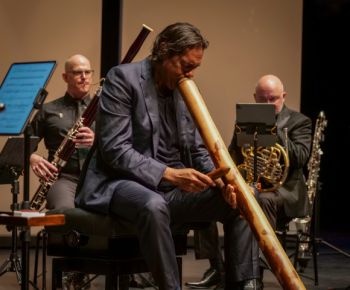
The first movement New Paths is inspired by Dean and his wife Trish walking their dogs. The cello ‘sings’ in this movement and produces tones that are not often heard from this instrument. The effect is magical bridging the gap between strings, wind, and woodwind instruments.
The second movement Under the Canopy is just what is says, light filtering through the branches of leopard trees. The explosion of light and colour is perfectly reflected in Dean’s music and includes a magnificent bassoon solo.
The third movement Homage to Les Six is inspired by Dean’s love of Poulenc and features a frenzied ending.
The second half of the evening begins with Brahm’s Cello Sonata No. 1 in E minor, Op. 38 (arr. Breuer). Originally written as a sonata for cello and klavier with the klavier being an equal partner to the cello and not simply an accompaniment. It was artfully arranged by Heribert Breuer for wind quintet, cello and double bass.
The first movement (Allegro no troppo) is in long lined sonata form with melody swapping between cello and the rest of the ensemble. The second movement (Allegretto quasi Menuetto) is generally quiet and often staccato. Characteristic of this section is the use of ornamentation that has a French baroque feel.
The third movement (Allegro) is fugue-like and frenetic and a fitting conclusion to the sonata.
The evening concludes with William Barton’s Journey to the Edge of the Horizon (2024). Barton is Australia’s leading didgeridoo player, composer, multi-instrumentalist, and vocalist and was named Queensland Australian of the year in 2023.
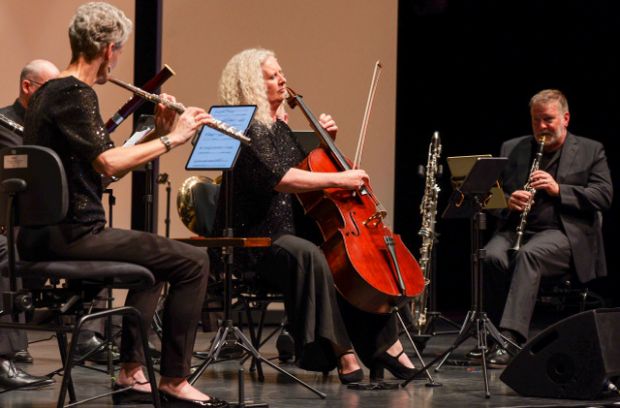
He is truly the Master of the didgeridoo and produces sounds not often heard on one of the oldest musical instruments of the world. For me, this was the highlight of the evening. Barton captures the colours and sounds of the Australian bush perfectly, the wind whistling through the spinifex grass, the animals, birds, and other environmental sounds using 4 different didgeridoos and his voice which he treats like another instrument, no words, just pure sound.
Barton’s music is more than a concert item, it is truly a ‘scared experience,’ and I felt privileged to share in it. A sentiment which was shared by the rest of the audience.
I watched from the dress circle and would have liked the volume on the didgeridoo mike to be a bit louder as the lower notes occasionally became lost in the general sound, but this is a minor point.
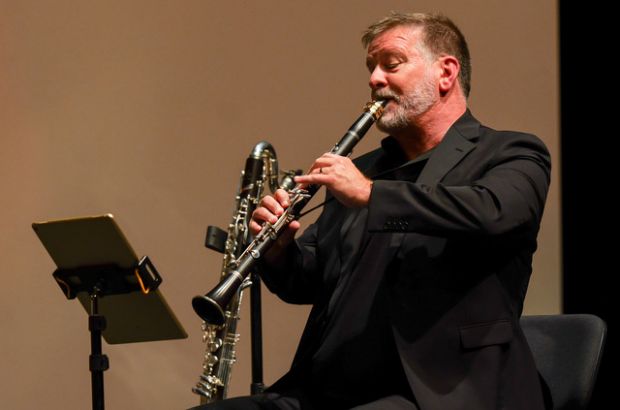
Ensemble Q and William Barton is a night with something for everyone, young or old, music aficionado or not. It will leave you with a greater appreciation of music across the centuries and cultures. Australia has every right to be proud of these musicians!
Barry Hill OAM
Subscribe to our E-Newsletter, buy our latest print edition or find a Performing Arts book at Book Nook.

